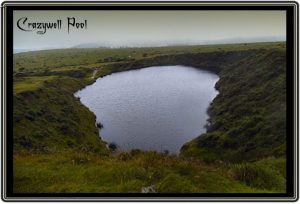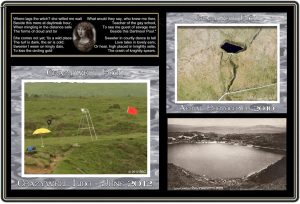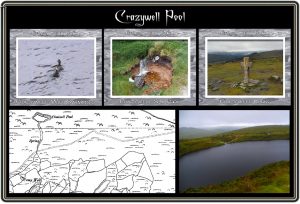
“Nature, passing nigh Cramber Tor, where old-time miners delved for tin, has found a great pit, filled the same with sweet water, and transformed all into a thing of beauty. Like a cup in the waste lies Crazywell ; and, at this summer season, a rare pattern of mingled gold and amethyst glorified the goblet. Autumn furze and the splendour of the heath surrounded it; the margins of the tarn were like chased silver, where little sheep tracks, white under dust of granite, threaded the acclivities round about and disappeared in the gravel beaches beneath. (Phillpotts, p.194).
Crazywell, Classenwell, Classiwell, or Clazywell, call it what you wish, lies below Cramber tor, its dark waters are said to be bottomless. For centuries Crazywell held the reputation of being the largest natural pool on Dartmoor and this claim can be read in many of the early topographer’s work. However, this myth was exploded as it is said that the villagers from nearby Walkhampton (or Sheepstor depending on which version) decided to find out exactly how deep the waters were and so they took all the bell ropes from the church, tied them together and lowered them into the middle. It was estimated that the ropes sank to between 80 – 90 fathoms (540ft) and still didn’t find the bottom. Several newspaper reports of the 1870s tell of how despite sounding the depth with bell ropes the locals then got a steam engine and began pumping the water out – it took only three hours to drain it completely. The pool still sits below Cramber tor with its dark menacing waters. Although for many years the myth of it being bottomless has been dispelled. Page, (1895, p.150), writes how in the particularly dry summer of 1844, water was pumped from the pool into the nearby Devonport Leat. The resulting drop in depth revealed that the waters were only about 15ft (4.5m) deep. The Rev. E. W. L. Davies wrote; “Great numbers of fish have been placed in it at different times, but never seen afterwards. The pool appears to be subject to periodical falls and rises. On April 22, 1824, at half-past three in the afternoon, it was higher by 2 feet than at the earlier part of the same day, and it was 12 feet higher than that in April, 1823.” –p. 148.
The pool lies at the top of a mining gert which indicates that it was not a natural feature but like so many of Dartmoor’s pools, it is the flooded result of mining activities. Mike Brown notes how this tinworks has in the past been blamed for the early silting up of the Plym Estuary due to large amounts of sand etc being taken down into the nearby Newleycombe Lake and then into the Mewy before finally ending up in the River Plym and from whence it was transported down to Plymouth. (1998. p.9).
Eden Phillpotts described the pool as being surrounded by ‘Autumn Furze‘ thus transforming it into a thing of beauty. Well that mantle of furze is no longer there and it appears that it is not the only thing to have disappeared, William Crossing laments the demise of heather as well; ‘At the present time the steep banks of Crazy Well Pool (sic), on Walkhampton Common, boast scarcely a heather plant; fire has denuded them of their covering, and it will be long ere the deep waters again reflect the purple bloom that once clothed them.’, (1966, p.45). As far as the actual place-name is concerned there is very little known, the best that even the Place-Name Society can come up with is the fact that in The Devon and Cornwall Notes and Queries it was Clasiwell Pool with a date of 1648. (Gover et al. p.246). Also associated with the name Clasiwell was a one-time farm, a hill, a clapper bridge, and a mining gert in which case it would be fair to assume that all these landscape features took their name from the farm which is odd as early maps list it as Crazywell but the pool as Clasiwell? Now, how the farm got it’s name is another mystery.
Be it a bottomless pool of the remains of early mining work Crazywell pool has a wealth of legend and folklore attached to it. People also talk about how the depth of the pool rises and falls with the tide at Plymouth and Baring Gould adds further mystery to the pool along with another version of its name;“Hard by is Clakeywell Pool, by some called Crazywell. It is an old mine-work, now filled with water. It covers nearly an acre, and the banks are in part a hundred feet high. According to popular belief, at certain times at night a loud voice is heard calling from the water in articulate tones, naming the next person to die in the parish. At other times what are heard are howls as of a spirit in torment,” (1982, p.231).
In 1903 a local farmer, John Pearce, was out searching for his ponies near to Crazywell Pool when he spotted the body of a ‘big man’ floating in the pool. He was described as being respectably dressed in a dark blue suit, and wearing a pair of kid gloves, was bold with a dark moustache. There was nothing on the body to identify the man apart from the letter R. W. embroidered on an handkerchief, a watch chain with no watch, a pair of gold cufflinks. and the words ‘St. James’s’ embroidered on the shirt collar. Nobody in the neighbourhood had seen such a person who was deemed to be a complete stranger and the doctor who examined the body though it had been in the water for about a fortnight. There were no visible signs of a violent attack and at the inquest the Coroner’s jury returned an open verdict.
Similarly, on Midsummer’s Eve anybody who gazes into the waters will see a likeness of the next parishioner to die. There is a fairly modern tale of how one night somebody was relating the legend of the pool in a local inn. Two young lads heard the story and laughed into their beers. A challenge was laid down that on the next Midsummer’s Eve they would not dare to go to the pool. This bet was accepted and the boys duly went up to the pool on that fateful night. As it was quite a hike they decided to drive up on a motor cycle. Nobody knows what they saw or heard because on the way home the bike sped of the road and killed them both. The pool was also used for military training purposes and several years ago (1998) a young marine tragically drowned there whilst on an exercise.
During one of his banishments from the royal court, Piers Gaveston is said to have hidden himself here until which time it was safe to return. His purpose for the visit was to consult the ‘oracle of the pool’ about his future, another version was that he consulted the ‘Witch of Sheepstor who predicted that “his humbled head shall soon be high.” Crossing, (1987, p.86) tells of how this tale of Gaveston can be attributed to the Reverend John Johns who in the early 1800’s wrote a poem entitled ‘Gaveston on Dartmoor‘: The witch doesn’t appear but as Gaveston looks at his reflection it turns to that of the old crone. A rush in the pool then starts to write on the waters surface: “Fear not, thou favourite of the king, That humbled head shall soon be high.” Taking this to mean it would be safe he returned to court but eventually found himself infront of the executioner, the poem ends: “Beside the block his thoughts recall That scene of mountain sorcery – Too late for high on Warwick wall In one brief hour his head will be.”
Today Crazywell Pool has become famous as a wild swimming spot, the Outdoor Swimming Society describe it as; “deep and often chilly, and big enough for a nice swim around. It’s on the high moor, fully exposed to the elements. You can float and listen to the skylarks’ song tumbling on the breeze.” The pool even made received a feature on BBC Devon due to the efforts of an artist called Alex Murdin. He decided to tote a red flag and pole, a lifeguard’s chair and parasol up to the pool and call it a ‘ natural lido’? This event occurred on the 17th of June (2012) and apparently attracted over 70 swimmers, clearly the spooky tales never put them off. I visited the pool on a very wet and misty July day (2012) and apparently the weather was far too bad for any wild swimmers, well that’s not exactly true, there were two ‘wild swimmers’ – a mother mallard duck and her youngster. It is truly amazing what comforts nature has afforded anyone wanting to swim in Crazywell Pool, on the track just below is what can only be described as a natural ‘Spa Pool with Shower’ as can be seen below. By the way, if you visit pool, don’t forget to have a look at the nearby wayside cross known as Crazywell Cross. It is possibly one of several that mark an ancient trans-moor track which has been called the ‘Maltern Way‘.

Baring Gould, S. 1982. A Book of Dartmoor. London: Wildwood House Ltd.
Brown, M. 1998, Dartmoor Field Guides – Vol. 12. Plymouth: Dartmoor Press.
Crossing, W. 1987, The Ancient Stone Crosses of Dartmoor, Devon Books, Exeter.
Crossing, W. 1966. The Dartmoor Worker. Newton Abbot: David & Charles.
Rev. Davies, E. W. L. 1863, Dartmoor Days. London: Longman
Gover, J. E. B., Mawer, A. & Stenton, F. M. 1992 The Place Names of Devon, English Place-Name Society, Nottingham.
Page, J. Ll. W. 1844 An Exploration of Dartmoor, Seeley & Co, London.
Phillpotts, E. 1908. The Virgin in Judgement. London: Cassell & Co. Ltd.
 Legendary Dartmoor The many aspects past and present of Dartmoor
Legendary Dartmoor The many aspects past and present of Dartmoor




7 comments
Pingback: Short Dartmoor Walk – The Devonport Leat | Dartmoor Hiking
Pingback: Our First Hike on Dartmoor, Devonport Leat - Paws and Tors
Pingback: Crazy Well Pool | Dartmoor Hiking
Pingback: A walk to Crazywell Pool | Dartmoor Hiking
Pingback: Shoot 4- Preparation – Final Major Project
Pingback: Tavistock Abbey to Buckfast Abbey Monastic Path: Part 2 – Walkhampton Church to Siward’s Cross – A Walk in English Weather
Pingback: Nun’s Cross Trail - WillCycle